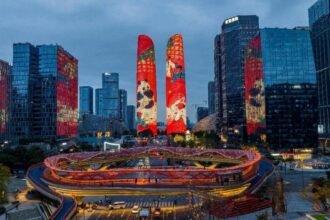Ayman Shad
The recent wildfires in Los Angeles have devastated vast areas, claiming lives, destroying properties, and severely impacting the environment. Understanding the causes, effects, and prevention strategies is crucial to mitigating future disasters.
Los Angeles is contending with multiple wildfires, notably the Palisades and Eaton Fires. The Palisades Fire, which ignited on January 7, has consumed over 23,000 acres in Pacific Palisades, leading to the evacuation of hundreds of thousands of residents. Tragically, it has resulted in at least 25 deaths and the destruction of approximately 12,000 structures. The Eaton Fire, also starting on January 7, has burned over 14,000 acres in Altadena. This fire has claimed 17 lives and led to the evacuation of over 100,000 residents.
Firefighters have made progress as strong winds have decreased, allowing for increased containment efforts. Los Angeles Mayor Karen Bass has expressed optimism, noting that the city’s two major wildfires haven’t grown recently. Efforts are ongoing to clear hot spots and address risks during the cooler, calmer weather, though future Santa Ana winds pose a threat.
Causes of the LA Wildfires
The cause of the fires is under investigation, with some reports suggesting a possible link to faulty power lines. However, the region’s prolonged dry conditions, with negligible rainfall over the past eight months, have created a highly flammable environment. Prolonged drought and strong Santa Ana winds have contributed to these hazardous conditions. Rising global temperatures and shifting weather patterns exacerbate the frequency and intensity of wildfires.
Effects of the Wildfires
The impact of these wildfires extends beyond immediate destruction. Thousands of residents have been displaced, with significant loss of lives and destruction of homes and infrastructure. Notably, the childhood home of actresses Zooey and Emily Deschanel in Pacific Palisades was destroyed by the Palisades Fire.
The entertainment industry has also been affected, with numerous celebrities impacted and the cancellation of premieres, events, and various film and TV productions throughout the city. Chief Kristin Crowley described the Palisades Fire as one of the most destructive natural disasters in the city’s history.
These wildfires are among the most destructive in California’s history, highlighting the increasing frequency and severity of such events, which are exacerbated by climate change. These fires have caused mental health issues among citizens due to fear and loss. Smoke and particulate matter have polluted the air, increasing health risks for respiratory conditions.
Recovery costs, property losses, and disruptions to local businesses have strained the economy. The state has increased its firefighting budget and resources, with a recent boost of $2 billion to CalFire. The state has implemented power cuts to prevent fires from spreading via electrical means. Despite preparedness and early evacuations, challenges remain. Governor Gavin Newsom is seeking additional state funding for emergency response, while FEMA provides relief for affected residents.
Public Perspectives
· Local Communities: According to the local community, this fire is a result of the repeated speeches of the upcoming President of the U.S., in which he says, “I will make a hill of Palestine.” This fire is what we call Azab from God, to show them how their words can fall back on them.
Some conspiracy theories suggest the fires were intentionally set to push environmental policies, reflecting skepticism about climate change as the main cause.
· Environmental Activists: Climate advocates highlight the role of global warming and demand stronger environmental policies. They argue that the fires result from rising global temperatures and prolonged droughts. These wildfires release massive amounts of carbon dioxide, leading to deforestation, loss of biodiversity, and destruction of wildlife habitats, further contributing to climate change.
WHAT IF!
If America, the superpower, is unable to take control of such situations, imagine how any other country in the world would handle it. And imagine if we faced this type of situation; what would we do? Look at yourself and think about it!
Let me give you the example of my hometown. Last summer, one of the mountains called Jalilabba caught fire, and we were unable to control it for a whole week. The local people and authorities were trying their best but were unable to stop it, just watching it spread over the mountain. If we cannot control a fire on Jalilabba, how would we manage something like the LA wildfire? We know that we can’t. So, the thing we should do is protect our environment and try to reduce factors like global warming and climate change, which cause such situations. Prevention is better than cure, and it will be useless to cry over spilled milk later.
According to me, Pakistan should have special funding for natural disasters, so that we are not sitting here waiting for other countries to help us.
Role of Climate Conservation in preventing such incidents:
Climate conservation plays a vital role in wildfire prevention, not only now but in future too. Sustainable practices, reforestation, and reducing carbon emissions can mitigate climate-induced disasters. Global cooperation and local initiatives are essential for long-term resilience.
Conclusion
The Los Angeles wildfires are a powerful reminder of the devastating impact of climate change and environmental neglect. If a developed nation struggles to manage such disasters, it raises concerns for more vulnerable countries like us. This calls for immediate action through climate conservation, sustainable practices, and stronger policies to reduce global warming and environmental risks. By prioritizing prevention and fostering global cooperation, we can better protect our communities and ecosystems from future catastrophes.
A student of English Literature at University of Malakand.









